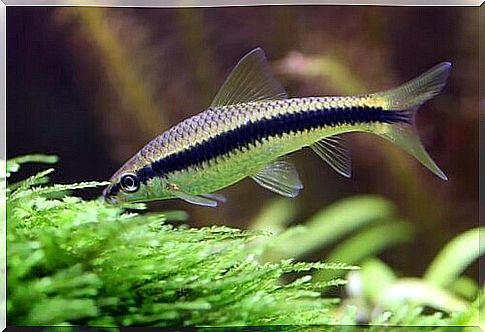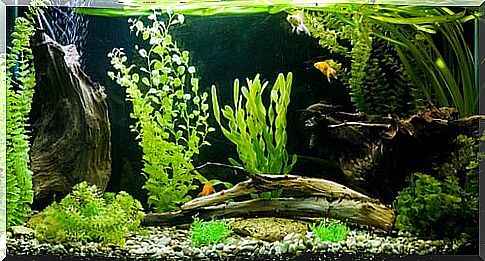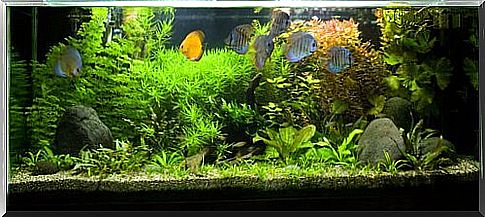Do You Have Too Many Algae In The Aquarium? Here’s How To Do It

Algae are small aquatic plants that can be inserted or even appear in aquariums. While they seem totally harmless, their proliferation can damage the ecosystem balance in these home fish tanks. If you have too many algae in your aquarium, we will give you a series of useful tips to solve the problem effectively and quickly.
Whether you have a small or large one, these seedlings can change the look of your home aquatic ecosystem. The fish may have less swimming space, the water may appear cloudy, dirty. In short, in case you have too many algae in the aquarium , you will need to act in a timely manner.
Too many algae in the aquarium: causes and solutions
In principle, it is important to understand that there are different types of algae that can appear in your aquarium. Knowing how to identify them is essential to establishing adequate treatment and effectively combating them. Below, we will introduce you to the main species of algae that grow most easily in fish tanks.

Pinpoint algae
They are probably the most harmless, due to their non-aggressive behavior. In general, they proliferate when there is an excess of fertilization in the aquarium, mainly due to a high concentration of nitrates. They can also appear due to a phosphate imbalance.
To avoid the presence of these algae, it is recommended to change 30-40% of the water and temporarily suspend the addition of fertilizers (except potassium). Furthermore, it will be necessary to carefully clean the windows, always using suitable and non-toxic products.
Next, you will need to measure the levels of nitrates and phosphates in the water, to find out any imbalances. Once the results are obtained, it will be possible to check if there is an excessive amount of fertilizer and adjust the doses.
Brown algae
Brown algae often appear in aquariums and can be a problem, especially for newbies. They reproduce quickly and, due to their brown color, give a rusty appearance to the water. In severe cases, you will notice that the bottom of the aquarium also acquires a dark color.
Generally, their proliferation is related to an excessive concentration of phosphates in the water. Even poor lighting can promote growth. Fortunately, they are easy to combat and often disappear quickly, simply by eliminating fertilizers.
To combat these algae you will change 30% of the water and stop the administration of phosphates and nitrates. Next, you will check the degree and level of illumination. We recommend that you do a vacuum to remove as many algae as possible.
By following these steps, brown algae are very likely to disappear. Once done, you can clean up the aquarium. Before resuming normal management, measure and verify all levels of substances in the water. It will be the right opportunity to restore the balance that was lost.
Green diatomaceous algae
These are the most problematic and, at the same time, surprising algae that can infest an aquarium. They proliferate rapidly and their excessive presence clouds the water, which will lose its normal transparency. In case they are not fought quickly, their high concentration will make the water greenish, with a very unpleasant appearance.
Although they are more common in new aquariums, the exact reason for their growth is still unknown. These green diatoms are able to develop in different aquariums, with little or a lot of flora, with various types of fish. In short, it is a real emergency.
The primary goal is that the water does not change color. Replace 50% of the total volume before starting treatment. Repeat the operation after five days, when you will begin to appreciate a reduction in the amount of weed algae.
Once the excess algae have been sucked up and removed, you should avoid using fertilizers for a few days. You will also eliminate artificial lighting, limiting exposure to the sun by covering the aquarium.
Some experts also recommend adding a germicidal lamp to speed up treatment and increase its effectiveness. In general, after this shock treatment , the algae will decrease after 5-6 days. Only then can you change the water again and the aquarium will return to normal.

Tips to avoid too many algae in the aquarium
- Balance the levels of micro and macro elements : generally, the proliferation of algae is associated with an excess of substrates. Therefore, in order to prevent its growth, it is essential to periodically measure the levels of nitrates, phosphates, potassium, CO2, etc.
- Ensure good lighting : lighting is a vital aspect of life in your aquarium. The excess or lack of light favors the development of algae, depending on the species.
- Before choosing the artificial lighting and the location of the aquarium, it is essential to think about the intensity of the light that will be offered. In addition, special care must be taken during the summer not to overheat the water, which could accelerate the growth of algae.









